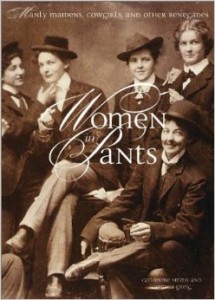 Women in Pants: Manly Maidens,
Women in Pants: Manly Maidens,
Cowgirls, and Other Renegades
by Catherine Smith and
Cynthia Grieg
Henry N. Abrams. 184 pages, $35.
THIS beautiful volume of terrific black and white photographs, printed on thick, glossy paper, brings to life a largely hidden history of women who traded their restrictive dresses for the clothes that “made the man.” Women in Pants is a collection of over 150 photographs collected by Catherine Smith and Cynthia Grieg, and includes daguerre-otypes from as early as the mid-19th century and the full range of photographic types—cartes de visites, postcards, gelatin silver prints, boudoir cards, and so on—as photographic technology advanced. The pictures display women in pants in a range of situations and circumstances that would undoubtedly astonish most contemporary viewers.







